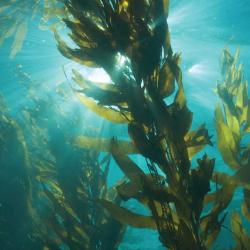Source Institutions
Source Institutions
Add to list Go to activity
Activity link broken? See if it's at the internet archive

In this culinary activity, learners use multiple senses (sight, smell, touch, and taste!) to explore real seaweed samples. They will compare and contrast land plants with kelp to review the structures and functions of parts, understand that algae is an important producer in aquatic environments, and learn how kelp is adapted to live along the California Coast. They will also explore various types of algae and discuss how the types differ from each other. This lesson guide is standards-based, and includes key vocabulary and wrap-up suggestions.
- 10 to 30 minutes
- 45 to 60 minutes
- $5 - $10 per group of students
- Ages 8 - 14
- Activity, Lesson/Lesson Plan
- English
Quick Guide
Materials List (per group of students)
- visual aids of giant kelp and other algae (search Manzanita images)
- Seaweed Salad Recipe sheet (one per student)
- samples of seaweed such as arame, wakame, kombu, hijiki; or, a mixed bag (kaisou sarada)
- plastic cups or Petri dishes (3-4 per station to hold seaweed samples)
- water
- paper towels
- colored pencils
- dixie cups (one per student)
- compostable forks or set of chopsticks (one per student)
- microscopes with Petri dishes or slides (optional for seeing station)
- 1 bag of dried wakame (or the seaweed of your choice!)
- rice vinegar
- soy sauce
- sugar
- sesame seeds
- large bowl for salad
- large strainer for salad
- small bowl for dressing
- tablespoon
- fork for stirring
- Sensational Seaweed! worksheet; option #1: with microscope (one per student)
- Sensational Seaweed! worksheet; option #2: without microscope (one per student)
Subjects
-
Life Sciences
-
Diversity of Life
- Plants
-
Ecology
- Ecosystems
-
Human Senses and Perception
- Touch
- Taste
- Smell
- Vision
-
Diversity of Life
-
The Nature of Science
-
The Scientific Process
- Gathering Data
-
The Scientific Process
Informal Categories
- Food and Cooking
Audience
To use this activity, learners need to:
- see
- smell
- taste
- touch
Learning styles supported:
- Involves hands-on or lab activities
Other
Components that are part of this resource:
Includes alignment to state and/or national standards:
Access Rights:
- Free access
